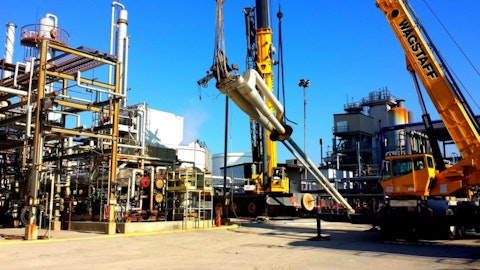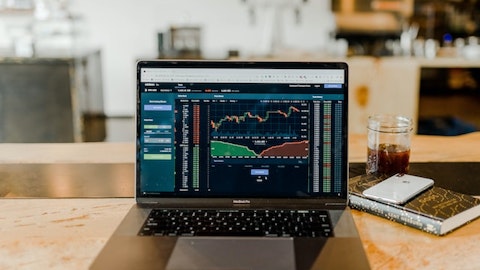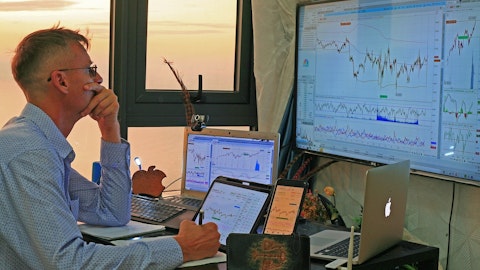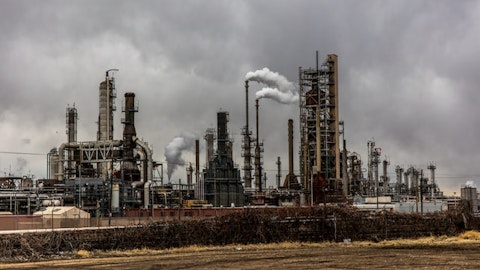Marathon Oil Corporation (NYSE:MRO) Q1 2023 Earnings Call Transcript May 4, 2023
Operator: Good morning, everyone, and welcome to the Marathon Oil First Quarter 2023 Earnings Conference Call. Please also note today’s line is being recorded. At this time, I’d like to turn the floor over to Guy Baber, Vice President of Investor Relations. Please go ahead.
Guy Baber: Thanks, Jamie, and thank you as well to everyone for joining us on the call this morning. Yesterday, after the close, we issued a press release, a slide presentation, and investor packet that address our first quarter 2023 results. Those documents can be found on our website at marathonoil.com. Joining me on today’s call are Lee Tillman, our Chairman, President, and CEO; Dane Whitehead, Executive VP and CFO; Pat Wagner, Executive VP of Corporate Development and Strategy; and Mike Henderson, our Executive VP of Operations. As a reminder, today’s call will contain forward-looking statements subject to risks and uncertainties that could cause actual results to differ materially from those expressed or implied by such statements.
I’ll refer everyone to the cautionary language included in the press release and presentation materials, as well as the risk factors described in our SEC filings. We’ll also reference certain non-GAAP terms in today’s discussion, which have been reconciled and defined in our earnings materials. With that, I will turn the call over to Lee and the rest of the team, who’ll provide prepared remarks. After the completion of those remarks, we’ll move to a question-and-answer session. Lee?
Lee Tillman: Thank you, Guy, and good morning to everyone listening to our call today. First, I want to say thank you to our employees and contractors for another quarter, a comprehensive execution against our framework for success. I’m especially grateful for your commitment to safety, differentiated execution, and environmental excellence. Well done on another great quarter, while staying true to our core values. We have a number of notable topics to cover today to continue to build on our peer-leading and market-leading financial and operational performance. I’ll start by reviewing some key takeaway consistent with the summary on Slide 5 of our earnings presentation. First, we reported another very strong quarter, both financially and operationally that is fully consistent with the guidance we provided back in February and further built on our track record of delivery.
We continue to execute against our differentiated cash flow driven return of capital framework, again exceeding our commitment to return at least 40% of our cash flow from operations to shareholders and industry-leading commitment. Our adjusted earnings per share handily beat consensus, and we generated strong free cash flow during first quarter, despite not receiving any E.G. cash dividends. The entirety of the variance in our cash flow and free cash flow versus consensus can be explained by the fact that we reported $80 million of E.G. equity income, but did not receive any E.G. cash dividends. This difference is strictly related to timing, and importantly, we expect to receive over $200 million of E.G. cash distributions during second quarter, more than making up for the first quarter delta versus consensus.
And in fact, we expect E.G. cash distributions to exceed E.G. equity income for full-year 2023. We continue to strengthen our already investment-grade balance sheet, proving we can both deliver industry-leading shareholder returns and reduce our gross debt. It’s not an either/or proposition. And operationally, first quarter oil production came in at 186,000 barrels of oils per day, consistent with our guidance. We expect an improving oil production trend into the second and third quarters, given our first-half weighted capital program and the associated timing of our wells to sales. Second key takeaway. Our full-year capital spending and production guidance remains unchanged. We remain on track to deliver our 2023 business plan, our plan that benchmarked at the very top of our high-quality E&P peer group on the metrics that matter most.
Those metrics include total shareholder distributions relative to our market capitalization, free cash flow yield and free cash flow efficiency, reinvestment rate and capital efficiency, free cash flow breakeven on both the pre and post-dividend basis, and growth in our production per share. This is strong evidence that not only the quality of our assets but the strength of our operational execution and the merits of our disciplined shareholder-friendly capital allocation and return of capital framework that focuses on per-share growth. And my third and final takeaway this morning. While we are focused on executing our 2023 plan that leads our sector, we’re equally focused on continuous portfolio enhancements to further improve our competitive positioning and longer-term sustainability.
We’ve now successfully integrated the highly-accretive Ensign acquisition ahead of schedule and we’re realizing excellent results from our initial wells to sales. We’re delivering tremendous results in the Permian Basin since our return to activity last year. Today, the Permian is effectively competing for capital on a heads-up basis with the best of the Eagle Ford and Bakken in our portfolio, a very high bar to clear. And finally. in Equatorial Guinea, we’ve made great strategic progress and further strengthening the longer-term outlook of our unique, fully-integrated global gas business. With that, I’ll turn it over to Dane, who will provide more detail on our 2023 outlook and how it stacks up to peers.

Pixabay/Public Domain
Dane Whitehead: Thank you, Lee, and good morning, everybody. Full year 2022 data shows that we performed at the very top of a high-quality E&P peer group last year, as well as the broader market, consistent with the charts on Slide 7 of our deck. An analysis of 2023 guidance indicates that our business plan again benchmarks at the very top of our sector and all the metrics that we believe matter most. I’ll start with a recap of our 2023 return of capital outlook summarized on Slide 8 of our slide deck. As I’ve stated many times on our earnings calls, returning significant capital to shareholders through the cycle remains foundational to our value proposition. We’re focused on building — excuse me, a long-term track record of consistent shareholder returns that can be measured in years, not just quarters, and 1Q was another step on that journey.
We again exceeded our commitment to return a minimum of 40% of our CFO, returning 42% to shareholders, including $334 million of share repurchases and our $63 million base dividend. Looking at the full year, we expect to continue adhering to our return on capital framework, while also paying down debt, including some of the Ensign-related finance. We believe we can do both, maintain our return-of-capital leadership and further enhance our already investment-grade balance sheet. And we’re off to a great start, beating our 40% of CFO target in 1Q, while paying down $70 million high-coupon USX debt and remarketing $200 million of tax exempt bonds at a very favorable rate. We’ll take down our remaining $130 million of USX debt in July and maturity.
We continue to believe our cash flow driven return of capital framework is uniquely advantaged versus peers, truly providing investors with the first call on cash flow and insulating shareholder returns from the effects of capital inflation. Offsetting inflation is on ops, not the shareholder. Even at our minimum 40% of the CFO commitment, our return of capital framework is sector-leading. It provides clear visibility to a double-digit distribution yield across a broad range of commodity prices as shown on the top-right graphic on Slide 8, and it benchmarks the very top of our peer group with a total shareholder yield about double the peer average. In terms of our preferred vehicle for shareholder returns, there’s no change to our approach.
We’ll pay a competitive sustainable base dividend with the lion’s share of shareholder returns coming through share repurchases. We currently have $2 billion of buyback authorization outstanding, which gives us plenty of room to keep executing. With our free cash flow yield in the high-teens, buybacks remain significantly value-accretive, a very efficient means to drive per-share growth, and highly synergistic withdrawing our base dividends, which we’ve raised eight out of last 10 quarters without compromising sustainability. Though peers have now migrated to our model, we were an early proponent of share repurchases and our dollar-cost averaging approach since October 2021 has delivered a peer-leading 22% reduction in our shares outstanding.
The strength and durability of our shareholder return profile underpinned by strong free cash flow generation and capital efficiency. While first quarter free cash flow was solid at $330 million, we expect both our underlying free cash flow and cash flow from operations to strengthen as we progress through the year. There are a number of factors driving this trend. As we mentioned, we didn’t receive any E.G. cash dividends during 1Q. We expect to start receiving those distributions in the second quarter, beginning with a larger-than-normal dividend of more than $200 million. Additionally, our CapEx is front-end loaded with 2Q capital spend expected to be comparable to first quarter consistent with our outlook for about 60% of our full-year capital to be concentrated in the first half of the year.
And the timing of this spend will drive oil production growth from 1Q levels, improving our cash flow generation capacity as we move through the year. Therefore, operationally and financially, we remain fully on track with the assumptions that underpinned our initial full-year free cash flow outlook provided earlier this year. And our 2023 outlook very clearly benchmarks at the top of our peer space as illustrated on Page 9 of the deck. We continue to trade at one of the most attractive free cash flow yields in the entire S&P 500, as the top-left graphic shows. While this meeting free cash flow yields is in part due to attractive valuation, it’s also a function of our peer-leading free cash flow efficiency. The top right graphic shows our free cash flow margins well above the peer average.
For every barrel we produce, we’re delivering 30% more free cash flow than the average high-quality E&P. Similarly, our reinvestment rate, a direct measure of capital invested versus cash flow generated, a true cash flow efficiency metric as it considers both capital and operating expenditures, is the lowest in the peer space, a full 10 percentage points below average. Further, our capital intensity is measured by CapEx per barrel of production, is more than 20% better than the peer average. This strong performance is a testament to not only the quality of our asset base but the strength of our operational execution and the discipline inherent in our capital allocation framework. Our focus remains on maximizing the free cash flow and corporate returns on every dollar we spend.
Turning to Slide 10, we benchmarked ourselves on one of the most important metrics for our sector, our free cash flow breakeven or the WTI oil price necessary to achieve free cash flow neutrality, a metric so important that we’ve hardwired it into our short-term incentive scorecard. Through disciplined capital allocation, ongoing cost structure optimization and a relentless focus on our capital and operating efficiency, our objective is to maintain the lowest sustainable free cash flow breakeven level. This is crucial to maintaining business model resilience and ensuring we’re positioned to deliver compelling free cash flow across a broad range of commodity prices. When commodity prices are healthy, we expect to materially outperform the S&P 500 in free cash flow generation.
When commodity prices are challenged, we expect to remain competitive with the S&P 500. And we can only do this by maintaining a low free cash flow breakeven. And Slide 10 shows we have the lowest 2023 pre-dividend free cash flow breakeven among high-quality peers at around $40 per barrel WTI. Additionally, we expect to realize significant improvement in our free cash flow breakeven from 2023 to 2024, largely driven by the expected financial uplift in E.G. So while our 2023 competitive positioning is strong, it’s even better in 2024. Finally, our free cash flow breakeven is also the lowest on a post-dividend basis. While we’ve raised our base dividend in eight of the last 10 quarters, we stay focused on base dividend sustainability and the synergies that exist between share buybacks and sustainable dividend growth.
Whereas certain peers now have base dividends that add $10 or even $15 per barrel to their breakeven, our base dividend adds a more modest $3 to $4 a barrel, underscoring a sustainability and our headroom for longer-term growth as long as we continue to reduce our share count. Turning to Slide 11. While we’ve been a leading proponent of a capital allocation framework that strongly prioritizes corporate returns and free cash flow generation over production growth, the reality is that we’re leading the peer group in growth on a per-share basis. 2021 to 2023, we expect to grow our production per share by more than 40%. In 2023 alone, we expect to grow production per share by approximately 30% year-over-year. Absolute production growth is not the objective, but we do see value in significantly growing our underlying per-share metrics.
Two primary factors are driving our exceptional per-share growth profile. First, a consistent and disciplined approach to shareholder returns with a strong emphasis on buybacks. Through our buyback program, we’ve reduced our share count by 22% in the last six quarters. Our peers have moved toward our model, but we’re definitely enjoying a first-mover advantage. And second, the highly accretive Ensign acquisition, which increased our maintenance of oil production by approximately 12% with no increase in share count. So with that summary of our 2023 business plan and competitiveness, I’ll turn it over to Mike to provide a brief update on Ensign and our recent outstanding performance in the Permian.
Mike Henderson: Thanks, Dane. As we’ve stated, the Ensign acquisition checks every box of our M&A framework, immediate financial accretion, return of capital accretion, accretion to inventory life and quality and industrial logic with enhanced scale, all while maintaining our financial strength and investment-grade balance sheet. We stated before our early focus with Ensign has been on integration and execution. Today, I’m happy to report that our integration of the asset is now complete. With a faster-than-anticipated timeline underscoring the execution confidence that comes with an acquisition and an established basin where we have a track record of success. And on the execution side, as highlighted on Slide 12 of the deck, early well performance continues to demonstrate that the acquired inventory offers some of the strongest returns in capital efficiency in the entire Eagle Ford.
Of our first three parts, 14 wells in total, are delivering top decile oil productivity in the basin. We plan to bring online another 20 or so Ensign wells during the second quarter. These wells are expected to deliver accretive capital efficiency and financial returns with comparable oil productivity to our legacy Eagle Ford program. With that, let me turn to our Permian operations where the team has been delivering tremendous results since we returned to a higher level of activity last year. As a reminder, we effectively shut down our Permian program in 2020 during the COVID-related commodity price collapse. In hindsight, pausing activity was one of the best things we could have done, not dissimilar from the pause in activity we took in the Bakken during 2016, also during a period of low commodity price before we transformed the performance of that asset.
More specifically, in the Permian, our team spent the last couple of years better understanding our acreage position from a top-down, bottoms-up perspective and repositioning that asset for success. We closely analyzed peer results across the basin by taking a hard look at our well spacing and our completion designs and we worked diligently on traits to core up areas we like to enable the extended laterals we are drilling today. The culmination of this hard work is shown on Slide 13. Since returning to activity at scale during the second half of last year, we brought 23 Northern Delaware wells to sales, 18 of which are extended laterals with an average lateral length of about 9,000 feet. These 18 extended laterals are significantly outperforming the Delaware Basin top-quartile on a cumulative oil basis by about 30%, truly exceptional results that compete with the absolute best operators in the basin.
This well set also includes the strongest well in the entire Delaware Basin during 2022, the Thunderbird 014H in Red Hills, which produced over 380,000 barrels of oil during its first 180 days. Geographically, these 18 extended laterals are evenly split between our Red Hills and Malaga areas. And from this point forward, as we benefit from coring up our acreage footprint and high grading our development program, we’ll almost exclusively be drilling the extended laterals. With these results, the asset is now effectively competing for capital against the best in the Eagle Ford and Bakken in our portfolio, which is no easy task and enhancing the long-term outlook for our company. I’ll now hand it back to Lee, who will provide an update on our E.G. operations and then conclude our prepared remarks.
Lee Tillman: Thank you, Mike. As highlighted on Slide 14, we recently completed a significant planned E.G. turnaround and the asset is now back to normal operations. While the downtime reduced our second quarter E.G. production by about 12,000 oil equivalent barrels per day, it’s intended to contribute to stronger uptime for both the winter of 2023, as well as next year and beyond when we’ll benefit for more attractive pricing for our Alba equity gas. The turnaround impact is fully contemplated in our full-year production numbers. We are reducing our full-year E.G. equity income guidance by about $50 million, strictly due to lower assumed natural gas prices. However, we expect our E.G. cash flows to prove more resilient. E.G. cash distribution should actually exceed equity income this year, starting in second quarter, illustrating the strong cash flow nature of the assets plus a bit of catch-up in dividends from prior quarters.
Looking ahead to 2024, we continue to expect to realize significant earnings and cash flow improvement on the back of an increase in our global LNG price exposure. While we’re still working through contractual specifics, the bottom line is, the beginning January 1, 2024, Alba sourced LNG will no longer be sold at a Henry Hub linkage. It will be sold into the global LNG market, which is expected to drive a significant financial uplift for our company, given the material arbitrage between Henry Hub and global LNG pricing. Yet, it’s not just about capturing commercial uplift in E.G. We’re equally focused on the longer-term outlook and fully leveraging the value of our unique infrastructure in one of the most gas prone areas of West Africa to enhance our multiyear free cash flow capacity.
That’s exactly what our recently-signed HOA summarized on Slide 15 as intended to accomplish. A few elements of the recently-announced HOA are worth highlighting. For clarity, Phase 1 of the E.G. Regional Gas Mega Hub is already completed and delivering value via the processing of third-party gas on a toll plus profit share basis from the Alen Field. Phase 2 of the Gas Mega Hub involves the expected 2024 cash flow uplift I just discussed, processing our equity Alba gas molecules under new contractual terms as of January 1, 2024, with linkage to the global LNG market. The HOA aligns all the critical parties on the necessary commercial principles to that end. Under Phase 2, we’re also analyzing the potential for infill drilling on our Alba block, giving — given our alignment across the value chain for equity Alba molecules.
Recall that we have a 64% working interest in the upstream Alba Unit and a 56% working interest in the downstream E.G. LNG facility and are the operator of both. More specifically, we’re assessing up to a two-well program targeting high confidence, low-execution risks, shorter-cycle opportunity that could mitigate Alba base decline and maximize flow of Alba equity molecules through the LNG plant under more attractive global LNG-linked terms. These opportunities are expected to compete with the risk-based returns generated from our U.S. resource plays. Phase 3 highlights the next step in the development of the Regional Gas Mega Hub. The intent to process third-party Aseng gas at our facilities once capacity at the LNG plant begins to open up.
The Aseng gas cap blowdown can access the same upsized pipeline that was funded and constructed by the Alen partners. This is fully consistent with our long-stated objective to extract maximum value from our world-class E.G. infrastructure by keeping the LNG facility as full as possible or as long as possible. Phase 3 will effectively extend the life of the E.G. LNG facility into the next decade, enhancing our long-term free cash flow capacity. Beyond Phase 3, we’ll continue to assess additional opportunities with the same objective in mind. There is a lot of discovered undeveloped gas in the area and the path to monetization runs through our infrastructure. A recent cross-border agreement between E.G. and Cameroon opens the door to additional fast track opportunities in addition to other regional discoveries.
Turning now to Slide 16. I’ll close our call on the same slide we’ve used to conclude our remarks in recent quarters. For years now, I’ve reiterated that for our company and for our sector to attract increased investor sponsorship, we must deliver financial performance competitive with other investment alternatives in the market, as measured by corporate returns, free cash flow generation and return of capital or S&P, less E&P. We’ve delivered exactly that type of performance over the last two years and not just competitive, but at the very top. Our one line investment thesis, top-tier sustainable free cash flow yield at an attractive valuation with an advantaged return of capital profile, centered on per-share growth. And as our detailed 2023 competitive benchmarking slide show today, we’re well positioned to again lead both our peer group and the S&P 500 on the metrics that matter most.
This peer-leading financial and operational delivery is not a one-year phenomenon. It’s a continuation of a multiyear trend. It’s sustainable, underpinned by our high quality and oil-weighted U.S. unconventional portfolio, recently strengthened by the Ensign acquisition that is complemented by our unique fully-integrated global gas business in E.G. To close, I want to iterate — reiterate how proud I am of the way we positioned our company. We are results-driven, but it is also about how we deliver those results, staying true to our core values and responsibly delivering the oil and gas the world needs. And the world needs more energy, not less. The energy transition is really an energy expansion and oil and gas is uniquely positioned to drive global economic progress, defend U.S. energy security, lift billions out of energy property and protect the standard of living we have all come to enjoy.
With that, we can open the line for Q&A.
See also 15 Most Anticipated TV Shows of 2023 and 30 Least Developed Countries in the World in 2023.
Q&A Session
Follow Marathon Oil Corp (NYSE:MRO)
Follow Marathon Oil Corp (NYSE:MRO)
Operator: Our first question today comes from Arun Jayaram from JPMorgan. Please go ahead with your question.
Arun Jayaram: Yes, good morning. Lee, I wanted to get maybe a few more insights on the dividend expectations for 2Q out of E.G. and wanted to run some math by you. In the first half of the year, you — including 1Q actuals, you would expect to generate about $115 million of equity income based and on that $200 million dividend, that would suggest maybe an $85 million tailwind to cash flow relative to your equity income guide. So wanted to run that math by to see if that made sense to you.
Lee Tillman: Yes, Arun, thanks for bringing a little bit of clarity to this point, but your math is relatively spot on. And the reality is that we do have a little bit of dislocation from time to time between equity income and receipt of the cash dividend and we’re in that space in first quarter. But as you accurately stated, we’re going to more than make up for that in second quarter with a greater than $200 million cash dividend payment coming from E.G. LNG, but your math is spot on, Arun.
Arun Jayaram: Great. And just my follow-up, Lee, I wanted to go back to E.G. again. Looking at the 10-K, gross sales out of Alba we’re about 2 million tons per annum at the 3.7 million ton per annum facility. I know that the Alen volumes bring you closer to nameplate, but as you know, Lee, one of the bare thesis on the stock has been the fact that Alba volumes are declining, call it, at a 10% to 15% annum clip. And so, wanted to get your thoughts on how Phase 1, Phase 2, Phase 3 of your strategy on Slide 15 can help keep the plant full. The duration that you see from these opportunities and just broader thoughts on your — on Marathon continuing this capital-light strategy with third-party volumes or wanting to get more operating volumes through that facility.
Lee Tillman: Yes. Thanks for the question. You’re exactly right. Right now, coupling both the Alba equity volumes with the Alen volumes, we’re at a relatively high utilization rate through the physical plant. And that was really part of the design of Phase 1 was to ensure that with a long life, low decline deals like Alba, coupled with some third-party volumes, in this case Alen, that we would kind of bridge to that next set of opportunities and keep that facility utilized. And that — that’s been networks — that work’s completed. We now have another piece, the fantastic infrastructure and a pipeline that connects us with the Alen Field. So that phase is doing exactly what it was designed to do. As we look out ahead, Phase 2 is really dominated by really the shift in the commercial structure, which is less about really production volume and more about gaining more exposure to the global LNG market and the associated cash flow uplift that we’ll see from that, of course.
Even though we’ve seen a weakened gas environment, the reality is that the arbitrage between Henry Hub and global LNG pricing remains intact, and so that’s going to be a value uplift. And an additional element that we’ve kind of brought into play as part of Phase 2 has been the fact that we are evaluating the potential for some Alba infill drilling opportunities, which have the potential to mitigate some of that base decline, but also allow us to move equity — high-value equity molecules through the E.G. LNG facility. And just for clarity, we’re still in the early days in that evaluation, but these are going to be — this is relatively shallow water. This is jack-up drilling, dry trees, so when you think about it from a capital standpoint, there is not — these are not going to be material movers in our capital budget.
That will also be kind of phased out in time. And the test for those is just making sure that those do compete head-to-head with the opportunities, of course, that we have here in the U.S. So that’s a little bit of an addition that we weaved into the story this quarter. And then, finally, when you get to Phase 3, this is again looking at third-party molecules coming from that broad kind of Alen-Aseng area, this is a gas cap associated with the Aseng Field that, of course, is operated by Chevron, just like the Alen is, and it’s our view that we will be the monetization path for that, and that was part of the HOA that was signed with E.G. and other relevant parties. The positive there is all of that work, Phase 1, Phase 2 and Phase 3, really extends us out through into the next decade.
So it gives us this runway to now advance additional opportunities. So what could be beyond Phase 3? Well, we talked about and I mentioned in my opening remarks the bilateral agreement between E.G. and Cameroon, that opens up the aperture to cross-border opportunities. And quite frankly, as I said in my remarks, this is one of the most gas-prone areas in West Africa. There’s a numerous discovered, undeveloped opportunities that E.G. LNG could provide a very efficient and profitable monetization route.
Arun Jayaram: Great. Thanks a lot, Lee.
Operator: And our next question comes from Scott Hanold from RBC. Please go ahead with your question.
Scott Hanold: Yes, thanks. Just turning to the Permian, the results looked pretty impressive. And my question would be — is, can you talk about the depth of inventory and the sustainability of those extended laterals? And how do you kind of look at this play going forward? I mean it seemed like it was complementary to kind of the overall asset base, but it does seem like now it’s got the ability to really step up and be a bigger part of the portfolio. So is — what’s the depth of that inventory look like? And are you guys looking at opportunities to add to that acreage position?





